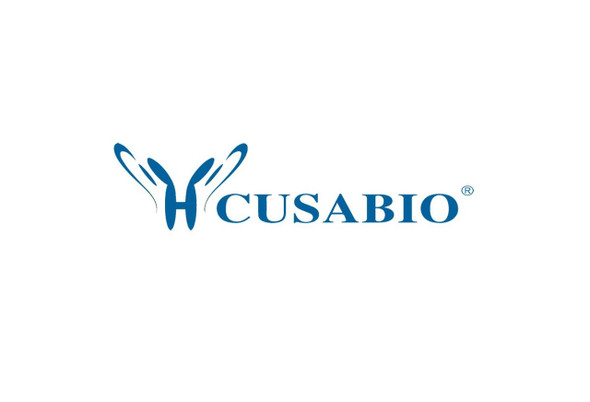Cusabio Active Proteins
Recombinant Human Interleukin-36 beta protein (IL36B) (Active) | CSB-AP002011HU
- SKU:
- CSB-AP002011HU
- Availability:
- 5 to 10 Working Days
Description
Recombinant Human Interleukin-36 beta protein (IL36B) (Active) | CSB-AP002011HU | Cusabio
Protein Description: Full Length of Isoform 2
Alternative Name (s) : FIL1 eta, IL-1 eta, Interleukin-1 family member 8, IL-1F8, Interleukin-1 homolog 2
Gene Names: IL36B,IL1F8,IL1H2
Research Areas: Immunology
Species: Homo sapiens (Human)
Source: E.Coli
Tag Info: Tag-Free
Expression Region: 1-157aa
Sequence Info: MNPQREAAPK SYAIRDSRQM VWVLSGNSLI AAPLSRSIKP VTLHLIACRD TEFSDKEKGN MVYLGIKGKD LCLFCAEIQG KPTLQLKEKN IMDLYVEKKA QKPFLFFHNK EGSTSVFQSV SYPGWFIATS TTSGQPIFLT KERGITNNTN FYLDSVE
Biological Activity: Fully biologically active when compared to standard. The specific activity is determined by its binding ability in a functional ELISA. Immobilized rHuIL-36β at 1 µg/mL can bind recombinant human IL-1 Rrp2 Fc Chimera with a range of 0.15-5 µg/mL.
MW: 17.7 kDa
Purity: >97% as determined by SDS-PAGE and HPLC.
Endotoxin: Less than 1.0 EU/µg as determined by LAL method.
Relevance: Cytokine that binds to and signals through the IL1RL2/IL-36R receptor which in turn activates NF-kappa-B and MAPK signaling pathways in target cells linked to a pro-inflammatory response. Part of the IL-36 signaling system that is thought to be present in epithelial barriers and to take part in local inflammatory response; similar to the IL-1 system with which it shares the coreceptor IL1RAP. Stimulates production of interleukin-6 and interleukin-8 in synovial fibrobasts, articular chondrocytes and mature adipocytes. Induces expression of a number of antimicrobial peptides including beta-defensins 4 and 103 as well as a number of matrix metalloproteases. Seems to be involved in skin inflammatory response by acting on keratinocytes, dendritic cells and indirectly on T cells to drive tissue infiltration, cell maturation and cell proliferation. In cultured keratinocytes induces the expression of macrophage, T cell, and neutrophil chemokines, such as CCL3, CCL4, CCL5, CCL2, CCL17, CCL22, CL20, CCL5, CCL2, CCL17, CCL22, CXCL8, CCL20 and CXCL1, and the production of proinflammatory cytokines such as TNF-alpha, IL-8 and IL-6. {ECO:0000269|PubMed:16646978, ECO:0000269|PubMed:20300079, ECO:0000269|PubMed:21242515, ECO:0000269|PubMed:21881584, ECO:0000269|PubMed:21965679, ECO:0000269|PubMed:24829417}.
PubMed ID: 10744718; 10625660; 11991722; 15815621; 15489334; 16646978; 20300079; 21965679; 21242515; 21881584; 24829417
Notes: Repeated freezing and thawing is not recommended. Store working aliquots at 4℃ for up to one week.
Function: Cytokine that binds to and signals through the IL1RL2/IL-36R receptor which in turn activates NF-kappa-B and MAPK signaling pathways in target cells linked to a pro-inflammatory response. Part of the IL-36 signaling system that is thought to be present in epithelial barriers and to take part in local inflammatory response; similar to the IL-1 system with which it shares the coreceptor IL1RAP. Stimulates production of interleukin-6 and interleukin-8 in synovial fibrobasts, articular chondrocytes and mature adipocytes. Induces expression of a number of antimicrobial peptides including beta-defensins 4 and 103 as well as a number of matrix metalloproteases. Seems to be involved in skin inflammatory response by acting on keratinocytes, dendritic cells and indirectly on T-cells to drive tissue infiltration, cell maturation and cell proliferation. In cultured keratinocytes induces the expression of macrophage, T-cell, and neutrophil chemokines, such as CCL3, CCL4, CCL5, CCL2, CCL17, CCL22, CL20, CCL5, CCL2, CCL17, CCL22, CXCL8, CCL20 and CXCL1, and the production of proinflammatory cytokines such as TNF-alpha, IL-8 and IL-6.
Involvement in disease:
Subcellular Location: Secreted
Protein Families: IL-1 family
Tissue Specificity: Expression at low levels in tonsil, bone marrow, heart, placenta, lung, testis and colon but not in any hematopoietic cell lines. Not detected in adipose tissue. Expressed at higher levels in psoriatic plaques than in symptomless psoriatic skin or healthy control skin. Increased levels are not detected in inflamed joint tissue.
Paythway:
Form: Lyophilized powder
Buffer: Lyophilized from a 0.2 µm filtered PBS, pH 7.4
Reconstitution: We recommend that this vial be briefly centrifuged prior to opening to bring the contents to the bottom. Please reconstitute protein in deionized sterile water to a concentration of 0.1-1.0 mg/mL.We recommend to add 5-50% of glycerol (final concentration) and aliquot for long-term storage at -20℃/-80℃. Our default final concentration of glycerol is 50%. Customers could use it as reference.
Uniprot ID: Q9NZH7
Uniprot Entry Name: IL36B_HUMAN
HGNC Database Link: HGNC
UniGene Database Link: UniGene
KEGG Database Link: KEGG
STRING Database Link: STRING
OMIM Database Link: OMIM









